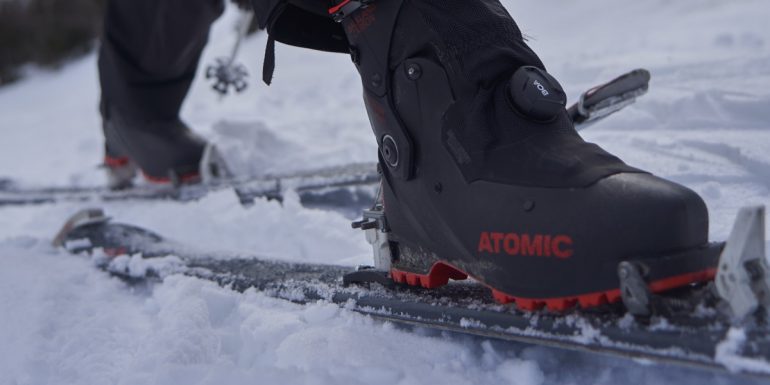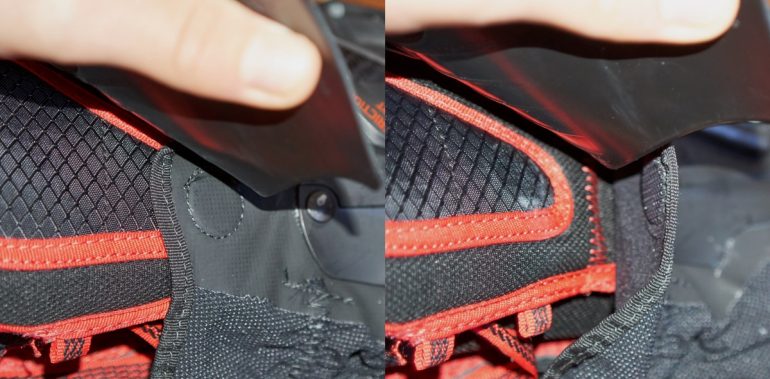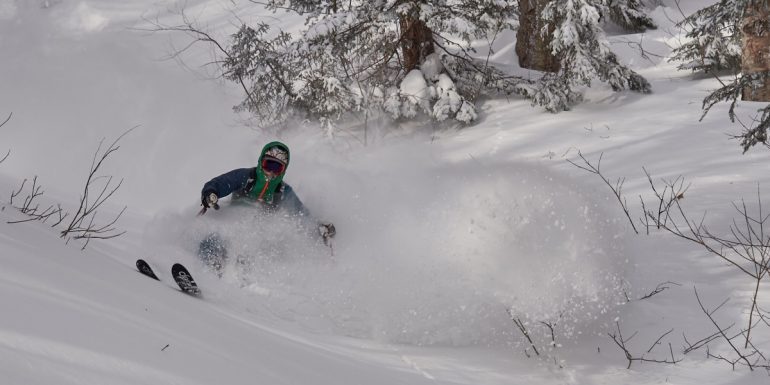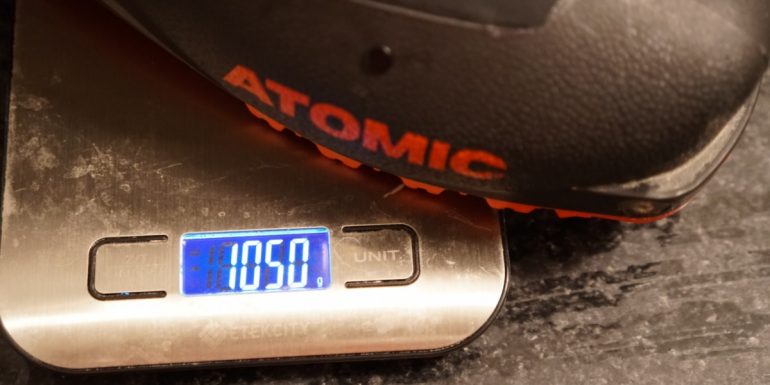Race, crud, powder — how the Backland Carbon stacks up
Written by Aaron Rice
I was ready to tell you a fantastic story about testing the Atomic Backland Carbon in creamy pow and perfect corn as I skied down an Arctic couloir straight to the ocean in the Westfjords of Iceland. Alas, Covid-19 had other plans. My loss is your gain, though, because let’s be real, you can’t tell much about a boot when conditions are perfect. Instead, I spent the past two months putting this boot through the ringer on the icy, crusty, and manky conditions of a Northern Vermont spring. Okay, I may be hamming it up a bit, I also got to ski them in some pretty awesome deep Vermont powder!
For the past seven years I’ve been a 3-buckle boot guy. I spent much of that time skiing in the Wasatch, the Andes, New England and beyond. I spent all of 2016 skiing 2.5 million human powered vertical feet and setting a new world record. I’ve operated under the philosophy that I needed two pairs of touring boots: one for fun skiing (the 3-buckle) and one for long adventures and skimo racing (a one buckle/boa style boot). The Atomic Backland is making a strong case that maybe I can shift this mentality, or maybe there’s room for a third boot in my quiver. In going into testing this boot, I was looking for that sweet spot crossover boot that I could take on long full day adventures without sacrificing too much on the down.
The boot
The Backland Carbon is the second lightest boot in Atomic’s ski touring line, weighing in @ 1094 g/boot for a 25.5. The range is from the Backland Ultimate @ 750 g/boot to the Backland Sport @1206 g/boot. It has a Boa over the foot with one cuff buckle and a lever walk mode. The Backland Carbon lives up to its name with a carbon spine running up the back of the boot.
This boot is intended for efficient touring and real skiing. It’s beefier than a skimo boot but smaller than a full-send 3 or 4-buckle AT boot. With these boundaries in mind, it delivers an incredible free range of motion at 74 degrees, is quite light at just over 1000 g, and can drive a ski surprisingly well for a boot with those specs.
Fit
Before I talk about fit, a little about my feet. I have a relatively standard arch height and foot width along with a very high instep (thick foot). There are a couple small bone spurs and problem spots, but nothing crazy. I also have very narrow calves. I wear a size 8.5 shoe (26 mondo) but almost always size down for ski boots to a 25.5.
At first, I could barely get the boot on. My instep was just too big to easily slide my foot into the boot. Once in, the boot is remarkably comfortable. Due to my small calves, I needed to move the buckle to the next tighter hole position. Easy. However, the power strap was mounted in such a way that I actually maxed out how tight it could get and still wanted it a bit tighter. I’m hoping to make some modifications to the power strap, but haven’t yet done so.
Overall, the boot fit true to size and other than the oddity of the power strap, and the struggle to get the boot on, once in, the fit was snug, cozy, and comfy.
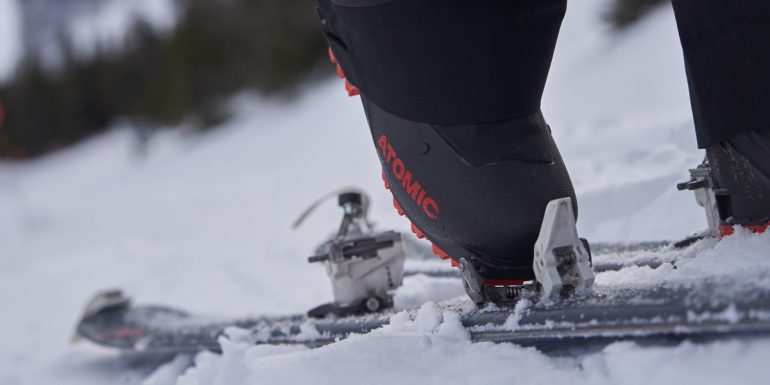
The Atomic Backland Carbon in its natural habitat, but it could be at a fancy restaurant too. Photo: Cyril Brunner
Backland Carbon highlights
The biggest highlight of the Backland Carbon is its SVELTness! It’s one of the cleanest and best-looking boots I’ve ever seen. While this has no relevance to how it skis, I felt like I could wear these things out to dinner!
Back to business, two of the Backland Carbon features especially stood out. The first is the free pivot walk mode (Frictionless Pivot in jargon land), and the second is the easy rear walk lever (Free / Lock 4.0 in jargon land).
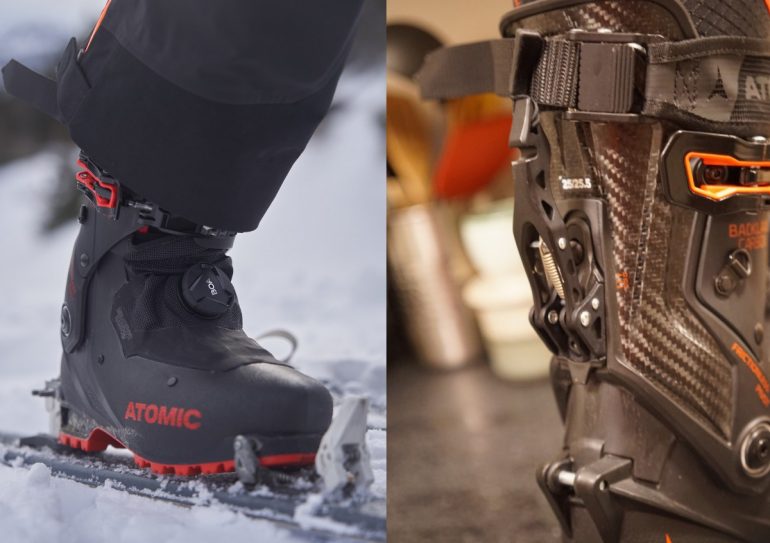
Range of motion in action, left. The Frictionless Pivot and Free / Lock 4.0 mechanism that makes it possible, right.
The frictionless pivot truly lived up to its name. I’ve been in a lot of boots that boast a high range of motion, only to find out that to fully experience the whole range you have to overcome a lot of resistance in the cuff and the liner. The Backland Carbon was not this way; I could easily achieve the full 74° range of motion.
I am coming from the Dynafit Ultra Lock walk mode system and have always been a big fan of the integrated buckle/walk mode and do miss it. However, the simplicity of the walk mode lever on the Backland Carbon won me over in the end. There is no finicky spot for ice to build up or weird walk mode shenanigans that we’ve all seen. It’s an easy flip of the lever.
The main highlight of the Backland was its incredible walkability and range of motion. On a scale of 1 – 10 (1 being an old school 4-buckle AT boot with a parking lot walk mode and 10 being the $2700 Pierre Gignoux SkiMo boot), the Backland Carbon scores a 7 for walkability. On a scale of 1 – 10 (1 being a plastic shelled SkiMo boot like the Scarpa Alien and 10 being an Alpine Race boot with a plug liner), the Backland scores a 5 for skiability. So overall, it is geared more for the uphill than the down.
Another feature worth noting, since it is pretty novel, was the magnetic cuff snaps (I guess I’ll call them that). These were a bit gimmicky to me and mostly got in the way more than anything else.
Durability
In the two months I used the boots, I didn’t come across any major durability issues. The liner is thin and I expect it would pack out a bit faster than a standard boot liner (or an intuition liner). I am also always a bit wary of the Boa systems breaking. This didn’t happen, but is always in the back of my mind.
Ideal uses
I think the best way to define a boot is to figure out what it’s not designed for. To do that I tested these boots at their limits.
As a skimo boot
I brought the Backland Carbon out to my local citizen SkiMo series to see how it could do as a SkiMo race boot. In terms of weight it fared okay against the competition at only ~350 g heavier than a true race boot. In terms of free rotation, it was pretty darn close. On super long stride and gliding portions of the course I noticed the back end of the range of motion, but only just barely. On the downhill… it’s SkiMo, so who cares? But actually, it was miles ahead of my SkiMo race boots, as expected.
If you are looking to be a competitive racer, I wouldn’t recommend this be your go-to SkiMo boot. However, it’s a great daily boot and if you don’t want to own a second pair of boots just for racing, this can 100% work in a pinch and get you much closer to the competition.
As a crud busting boot
To find the other end of the limits of the Backland Carbon, I found myself on top of what I hoped would be a soft corned up New England trail in the spring. However, the clouds rolled in and had different plans for our afternoon. What were soft moguls only minutes ago became bulletproof icy moguls of death.
On the climb, the boots were a dream: comfortable, great range of motion, I was able to keep my heel risers low and still maintain effective contact with the snow and not struggle to hold a grip even in the icy conditions.
I was skiing DPS Cassiar 95s. On the descent I was definitely feeling the lack of a burlier boot and found myself pining for the added stability of my 3-buckle boots. The Backlands had okay lateral stability, but even with a high rear cuff, I wished the sides of the boot were a bit taller (but you have to find weight saving somewhere I guess).
The forward flex was a little soft for my liking. I didn’t notice this in good snow, but when things got spicy, I wasn’t able to drive the boot as well as I would have liked. That said the skiing really wouldn’t have been any better, even in a bigger boot that day.
As a powder cruising boot
I took it upon myself to see what this boot was intended for and then do exactly what it was not intended for, you’re welcome. So now let’s talk about what the Backland was great at.
I took the Backlands out on a perfect corn day and flew up and down the mountain with ease. Easy walking, and easy to drive my skis on the down. I skied the Backland in pristine Vermont powder and was happy to be breaking trail with 70% the weight I’m accustomed to and with a better range of motion. On the down I was perfectly satisfied with the lighter boot, and found I was able to drive my skis well enough in the nice snow. I took the Backlands on long walks in the woods skinning 5-7k and found the walkability delightful!
Conclusion
Geared for the uphill at just over 1000 g with a true free 74° range of motion, the Backland does an adequate job on the down. While it’s not designed for big mountain sending, with its carbon spine and high rear boot cuff, it performs as expected for its weight class on the downhill. Looking past oddities in fit, and the superfluous magnets, the Backland walks pretty darn close to a SkiMo race boot due to the frictionless pivot. As a boot designed for the crossover athlete the Backland hits the marks on weight, and walkability, and does the job on the down.
SPECS
Weight (grams): 1094 g/boot (25.5)
Dimensions: Narrow last
Range of Motion: 74°
Construction: Carbon spine, Rocker Vibram sole
Buckles: 1 cuff buckle + Boa
Shop for it.
Read our other Backland boot coverage.
Aaron Rice loves skiing so much that in 2016 he skinned and skied 2.5 million human powered vertical feet, breaking the record for most human powered skiing in a calendar year. He now lives in Vermont living a slightly more sane lifestyle but still skis daily, getting about 125 days and 350,000’ per year. Follow along @airandrice!
Beyond our regular guest bloggers who have their own profiles, some of our one-timers end up being categorized under this generic profile. Once they do a few posts, we build a category. In any case, we sure appreciate ALL the WildSnow guest bloggers!

